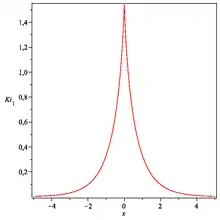
In physics, engineering, and applied mathematics, the Bickley–Naylor functions are a sequence of special functions arising in formulas for thermal radiation intensities in hot enclosures. The solutions are often quite complicated unless the problem is essentially one-dimensional[1] (such as the radiation field in a thin layer of gas between two parallel rectangular plates). These functions have practical applications in several engineering problems related to transport of thermal[2][3] or neutron,[4][5] radiation in systems with special symmetries (e.g. spherical or axial symmetry). W. G. Bickley was a British mathematician born in 1893.[6]
Definition
The nth Bickley−Naylor function is defined by
and it is classified as one of the generalized exponential integral functions.
All of the functions for positive integer n are monotonously decreasing functions, because is a decreasing function and is a positive increasing function for .
Properties
The integral defining the function generally cannot be evaluated analytically, but can be approximated to a desired accuracy with Riemann sums or other methods, taking the limit as a → 0 in the interval of integration, [a, π/2].
Alternative ways to define the function include the integral,[7] integral forms the Bickley-Naylor function:
where is the modified Bessel function of the zeroth order. Also by definition we have .
Series expansions
The series expansions of the first and second order Bickley functions are given by:
where γ is the Euler constant and
Recurrence relation
The Bickley functions also satisfy the following recurrence relation:[8]
where .
Asymptotic expansions
The asymptotic expansions of Bickley functions are given as[9]
- for
Successive differentiation
Differentiating with respect to x gives
Successive differentiation yields
The values of these functions for different values of the argument x were often listed in tables of special functions in the era when numerical calculation of integrals was slow. A table that lists some approximate values of the three first functions Kin is shown below.
| 0 | 1.570796327 | 1.000000000 | 0.785398162 |
| 0.1 | 1.22863188 | 0.862521290 | 0.692543328 |
| 0.2 | 1.023679877 | 0.750458533 | 0.612064472 |
| 0.3 | 0.868832269 | 0.656147929 | 0.541862953 |
| 0.4 | 0.745203394 | 0.575660412 | 0.480375442 |
| 0.5 | 0.643693806 | 0.506373657 | 0.426358257 |
| 0.6 | 0.558890473 | 0.446366680 | 0.378791860 |
| 0.7 | 0.487198347 | 0.394159632 | 0.336825253 |
| 0.8 | 0.426061805 | 0.348575863 | 0.299739399 |
| 0.9 | 0.373578804 | 0.308659297 | 0.266921357 |
| 1.0 | 0.328286478 | 0.273620752 | 0.237845082 |
| 1.2 | 0.254888907 | 0.21564418 | 0.189162878 |
| 1.4 | 0.199050709 | 0.17049927 | 0.150734408 |
| 1.6 | 0.156156459 | 0.135163924 | 0.120310892 |
| 1.8 | 0.122960838 | 0.107392071 | 0.096165816 |
| 2.0 | 0.097120592 | 0.085490579 | 0.076963590 |
| 2.5 | 0.054422478 | 0.048670845 | 0.044307124 |
| 3.0 | 0.030848237 | 0.027924583 | 0.025646500 |
| 3.5 | 0.017634408 | 0.016117448 | 0.014909740 |
| 4.0 | 0.010146756 | 0.009346971 | 0.008698789 |
| 4.5 | 0.005868829 | 0.005441695 | 0.005090280 |
| 5.0 | 0.003408936 | 0.003178387 | 0.002986247 |
| 6.0 | 0.001161774 | 0.001092877 | 0.001034238 |
| 7.0 | 0.000400052 | 0.000378912 | 0.000360620 |
| 8.0 | 0.000138841 | 0.000132222 | 0.000126417 |
| 9.0 | 0.000048484 | 0.000046377 | 0.000044509 |
| 10 | 0.000017015 | 0.000016336 | 0.000015728 |
Computer code
Computer code in Fortran is made available by Amos.[10]
See also
References
- ↑ Michael F. Modest, Radiative Heat Transfer, p. 282, Elsevier Science 2003
- ↑ Z. Altaç, Exact series expansions, recurrence relations, properties and integrals of the generalized exponential integral functions, Journal of Quantitative Spectroscopy & Radiative Transfer 104 (2007) 310–325
- ↑ Z. Altaç, Integrals Involving Bickley and Bessel Functions in Radiative Transfer, and Generalized Exponential Integral Functions, J. Heat Transfer 118(3), 789−792 (August 1, 1996)
- ↑ T. Boševski, An Improved Collision Probability Method for Thermal-Neutron-Flux Calculation in a Cylindrical Reactor Cell, NUCLEAR SCIENCE AND ENGINEERING:. 42, 23−27 (1970)
- ↑ E. E. Lewis and W. F. Miller, Computational Methods of Neutron Transport, John Wiley Sons, 1984.
- ↑ G. S. Marliss W. A. Murray, William G. Bickley—An appreciation, Comput J (1969) 12 (4): 301–302.
- ↑ A. Baricz, T. K. Pogany, Functional Inequalities for the Bickley Function, Mathematical Inequalities and Applications, Volume 17, Number 3 (2014), 989–1003
- ↑ M. Abramowitz and I. A. Stegun, Handbook of Mathematical Functions, pp. 483, Dover Publications Inc., (1972).
- ↑ M. S. Milgram, Analytic method for the numerical solution of the integral transport equation for a homogeneous cylinder, Nucl. Sci. Eng. 68, 249-269 (1978).
- ↑ D. E. Amos, ALGORITH 609: A portable FORTRAN Subroutine for the Bickley Functions Kin(x), ACM Transactions on Mathematical Software, December 1983, 789−792